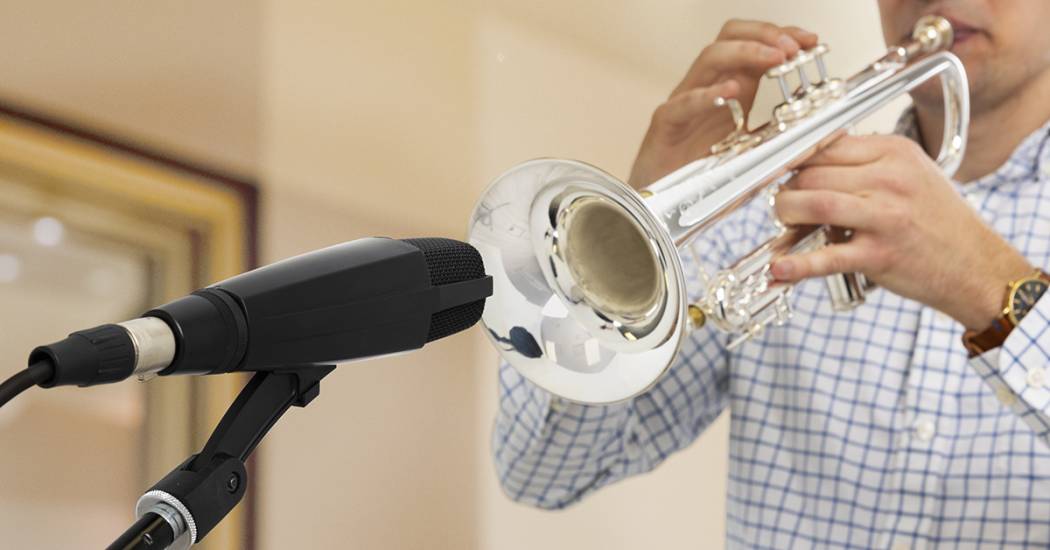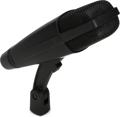
Did you know that Sweetwater carries band and orchestra products in addition to our comprehensive range of instruments and pro audio gear? Because we offer such a wide range of products, we frequently encounter brass musicians who want to know how to mic up a trumpet and aren’t sure where to start.
Regardless of whether you’re a seasoned studio engineer or a trumpet player with a basic knowledge of recording, miking up a trumpet for the first time can be pretty daunting. Like most brass instruments, trumpets can be a challenge to record because they’re super loud and can expose the weak points of just about any room. Today, we’ll run through some basic principles of miking up a trumpet in the studio and onstage. Along the way, we’ll recommend some microphones and give you tips for capturing the perfect sound.
Mic Selection
Since you can’t plug a trumpet straight into your DAW, you’ll need to think carefully about what microphone you want to use. Before you set up a microphone and press record, Sweetwater recommends that you listen to the trumpet in your space. Use your ears and assess the player’s tone. Are they shrill or mellow? Bright or dark? Breathy or direct? Gathering as much information as possible will help you narrow down your mic selection later.
Microphones for Trumpet
Here are some of the mics we prefer.
That’s not all you can use! Here are some other microphones that perform well on trumpet.
Instrument-mounted microphones
Which Mic Is Best for the Job?
The microphone you end up choosing depends, in large part, on what you want the final product to sound like. Of course, seasoned studio pros will be familiar with the general characteristics of each type of microphone. We’ll run through the basic microphone designs for those who are newer to recording. For further reading, check out this article: “How a Microphone Works.”
Condenser microphones
Generally, condenser microphones capture a highly detailed sound. These mics are a no-brainer if you’re looking for a clear and open sound. Keep in mind, a condenser sounds its best in a good-sounding room. Anything less will leave you with an undesirable sound because a poorly treated room may have unwanted reflections or rumbling AC units, or it may contend with the natural sounds of the outside world sneaking in.
Ribbon microphones
Known for their rich low end and smooth sound, ribbon microphones are a great choice for trumpets. They flatter just about every trumpet and do a spectacular job capturing the complex and powerful sound. A ribbon microphone’s figure-8 polar pattern makes it a little trickier to place than a directional microphone. Still, creative placement of the null points may help you lessen acoustic issues within your space.
Dynamic microphones
The tried-and-true dynamic microphone is always a good choice for trumpet — especially when you’re playing live. A dynamic microphone’s cardioid or hypercardioid pickup pattern helps it focus on the source directly in front of the mic and typically shrugs off unwanted room noise. For a more in-depth explanation of microphone polar patterns, check out our article, “Microphone Polar Patterns Demonstrated — Use Your Ears.” With a pair of headphones, you can hear the differences between all the different microphone polar patterns.
Where to Position the Microphone
Pick the sound you want, and here are pointers to achieve it.
Bright
The brightest sound comes from the center of the bell. To get that bright, brassy sound heard on so many outstanding records, place your microphone about 12 to 16 inches away from the bell and slightly off-axis. From there, point the capsule at the middle of the bell and let the player go to town. Make sure you use a pop filter to protect your mic of choice from blasts of air. The mic will get a much more direct and present sound with less room.
Mellow
If the piece calls for a more mellow trumpet sound, then a quick change of location will work wonders. With the mic about 24 inches from the bell, start moving it off-axis to one side until you find a darker sound you like. Experiment with your mic placement, and you’ll find the right sound in a jiffy.
Classical
Imagine you’re recording a university audition or an orchestral player’s demo tape. You won’t want to get a bright and jazzy sound! Instead, you’ll want something dark and rich. For a classical-style recording, place your microphone as far from the player as possible and about six feet off the ground. This will help tame the upper harmonics and will capture a sound akin to what a conductor would hear from the podium.
You should also consider using a stereo configuration to capture the essence of your recording space. Try using XY, A-B, or mid-side to let in more room tone. With the right mics in the right room, a stereo trumpet recording can sound amazing. For more stereo miking possibilities and what makes them great, read “7 Stereo Mic Techniques You Should Try.”
Live
For live recordings, there are two mic placement options. First, you can go with the tried-and-true stationary mic. Here, we recommend setting up an industry-standard dynamic microphone at playing height. Place it 10 to 12 inches away from the bell and have the player play straight into it. This will eliminate bleed from other sources and will create a bright and focused sound. If your player moves around the stage, then you’ll need to choose an instrument-mounted microphone. Clip it onto the bell and place the capsule slightly off-axis. You’ll get the same presence and isolation you need without forcing your player to stand still all night.
Optimize Your Signal Chain
You can plug a trumpet microphone directly into your DAW; but, for the best results, you’ll need a good signal chain to ensure that your recordings live up to their potential. Here’s some outboard gear that’ll do the job well every single time.
Audio Interface
The audio interface is the heart of your recording rig. It is responsible for transferring the analog signal from your microphone to the DAW. Don’t have your audio interface yet? Don’t worry; the gearheads at Sweetwater put together a useful Audio Interface Buying Guide to help you find the interface for you. Ready to upgrade your existing interface to something more advanced? Check out Sweetwater’s list of the best audio interfaces for your home studio.
Mic Preamp
Today’s audio interfaces include some pretty impressive microphone preamps. But, to really flatter a trumpet, you should run the signal through a standalone microphone preamp. An outboard mic pre offers the best possible sound, and most units have a host of useful features to tweak your sound. Remember that the trumpet is capable of extremely high SPLs. Be sure that your performer is completely warmed up and playing at full volume while setting your levels. That can save you from having to re-record something that peaks too high and distorts.
Solid-state mic preamps
A great solid-state preamp is ideal if you’re looking for clarity and detail. Here are some of our favorites.
Tube mic preamps
Lovers of the old-school sound naturally gravitate to tube microphone preamps. With these units, you’ll imbue your recordings with the textured warmth that defined golden-era music.
Consider Your Room’s Sound
The right room can make an ordinary take sound extraordinary. Conversely, an unflattering room can scuttle a once-in-a-lifetime performance before it even happens. And, when you’re dealing with a demanding instrument such as the trumpet, it’s best to record in a flattering setting. Unfortunately, most of us don’t have access to the Lincoln Center for the Performing Arts, so a treated room will have to do. To do a trumpet justice, make sure your space is tuned and treated to the best of your ability. Not sure where to start? Pick up some Auralex Studiofoam Wedgies or a Primacoustic London 8 acoustic room kit and call your Sweetwater Sales Engineer.
Sweetwater Has Everything You Need to Record Trumpet
The trumpet can be a finicky beast; but, with these guidelines and a little trial and error, a great sound is never far away. Sweetwater carries everything you need to mic up and record trumpet at home, in the studio, and onstage. For all your recording needs, be sure to call us at (800) 222-4700 and speak to your Sweetwater Sales Engineer.





